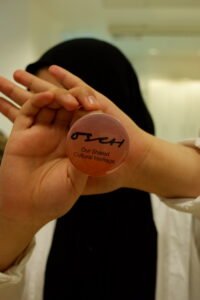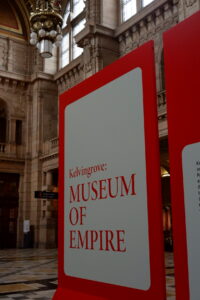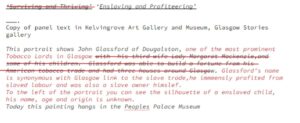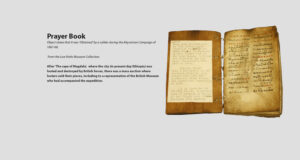Fresh Eyes: the importance of youth involvement - and vision - in realising policy goals
This blog by Chrislyn Pereira is the first in a set of commissioned blogs from the Our Shared Cultural Heritage(OSCH) Changemakers program . These blogs were commissioned to share their thoughts and reflections in the light of the Empire, Slavery & Scotland’s Museums recommendations to the Scottish Government in June 2022.

Introduction
Imagine this…
You enter a dimly lit room. Your vision briefly blurs as your eyes adapt to the dark. An array of objects float suspended in glass cases, accompanied by a short description of what the objects are, where they’re from, and occasionally, how they got there. Something catches your eye: an urn etched with deep grooves, not unlike wrinkles, forming an intricate pattern across its surface. It’s packed tightly into a small display case. You crouch down to read the small placard accompanying the display. It’s a sacred object, apparently. Hundreds of years old. You think that there’s something odd about this display – but the thought passes. The museum knows what it’s doing, right?
Perhaps.
We understandably rely on institutions to be a source of objective truths on history and culture. However, the prevailing narrative that accompanies Scotland’s history is rarely questioned for its objectivity and often escapes public scrutiny. It is an open secret amongst marginalised communities that we do not have a say in how history is remembered and relayed. With the power to shape historical narratives, and act as a repository of future memory, museums must take up the mantle of being inclusive and fair to the communities they serve and ask: “Is there a better way to remember, document and articulate history?” Such is a theme that emerges and is at the exploratory core of the Our Shared Cultural Heritage(OSCH) Changemakers program and the national Empire, Slavery & Scotland’s Museums (ESSM) project.
The ESSM Recommendations and work of the OSCH Changemakers
The ESSM Steering Group Recommendations (ESSM Recommendations), published earlier this year, outlined six recommendations that seek to address the enduring legacy of Scotland’s historical links to empire and slavery. They were conceived following an extensive public inquiry into the attitudes of museums to issues of racism, this being a derivative side effect of colonialism. The recommendations cover a broad range of themes from sustainability to support, forming a holistic push for widespread change that ought not to be taken out of context nor read in isolation. For ease of reference, the recommendations are listed below:
- Scotland should create a dedicated space to address our role in empire, colonialism and historic slavery. A new organisation should be created to lead this work.
- Museums should ensure anti-racism is embedded in their workplaces and public spaces.
- Museums should involve the people of Scotland in shaping their work through co-production, to promote cultural democracy and participation for all.
- Museums should commit to research, interpret, and share the histories of Scotland’s links to empire, colonialism, and historic slavery.
- Museums should support efforts to promote and embed race equality and anti-racism into the curricula in a meaningful, effective, and sustainable way.
- Scottish Government should demonstrate their support for restitution and repatriation of looted or unethically acquired items in Scottish collections.
As part of the OSCH Changemakers, it is fascinating to see the parallels that can be drawn between the work/projects that we have come up with/are working on, and the ESSM Recommendations.
OSCH Changemakers So Far
Glasgow MELA
In 2022, we had the privilege of exhibiting at MELA, the biggest multicultural festival in Scotland. Alongside a roster of events featuring the likes of Trishna Singh OBE and Deep Kailey of Without Shape Without Form, we were able to interact with the public and discuss projects that we had concluded (such as the Lascar Research Project) or that were still ongoing.
Museums of Empire display at Kelvingrove Art Gallery and Museum
We’ve also been granted an incredibly exciting opportunity to research, design and curate a display that will form part of the Museums of Empire exhibition at one of Scotland’s most popular museums. The display brings together a carefully curated selection of objects that dive deep into themes of Restorative Justice, Healing and Futurism.
With a view to being as transparent about the realities of colonialism and giving due respect to any displayed artefacts of the then-subjugated cultures, much thought and care is being integrated into the manner in which viewers should interact with the displays. The display offers a chance for us to influence the narrative and move towards our vision of decolonizing and diversifying museums into places that have the capacity and willingness to explore colonial history and its lingering present-day effects (such as concerns which are at the forefront of the climate justice movement).

Closing Thoughts
Now imagine this…
You’re back to looking at the urn and its brief placard. Now, where you assumed ignorance on your part as a viewer, you have questions: why is a supposedly-sacred object displayed in this way? Where did it come from? Could you find out more? And if you could find out more, could the museum have done too?
While you are left with questions rather than answers, this line of inquiry is an important part of collective breakthrough: it is a step forward towards a more inclusive and equitable form of remembrance that we can demand from our cultural institutions as well.

